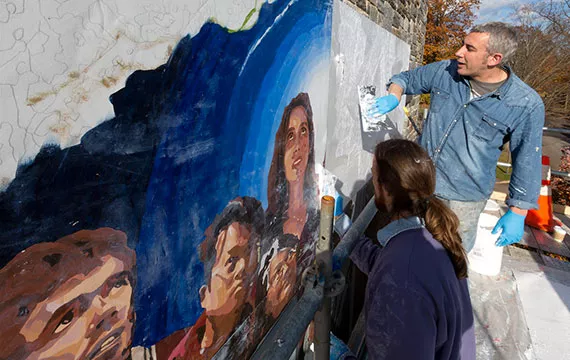Mellon Creative Residencies Program Enriches Tri-Co Community

Among the 47 artists showcased by the residences program is David “Dee” Craig (right), who painted a mural designed by Swarthmore College community members.
Argentinian video artist Leticia Obeid premiered her documentary project Media/Mediums at Swarthmore this week, the latest in the virtual kaleidoscope of programming offered by the Mellon Tri-Co Creative Residencies Program.
Obeid has split the past month between Haverford College and Swarthmore, meeting with students and faculty of the schools and Bryn Mawr College and attending lectures and talks — the type of informal but in-depth collaborations for which the Mellon program is known.
“Leticia’s presence as a working media artist has already been invaluable to Film & Media Studies students who are making their senior films,” says Professor of Film & Media Studies Patricia White, a member of the residencies program committee. “The way ideas, creativity, and craft are interwoven into her work is an inspiration.”
Obeid’s visit represents one of the final residencies of the program, which began with three years of funding in 2013 and will take an indefinite hiatus after the semester, says Thomas Bonner of the John B. Huford ’60 Center for the Arts and Humanities at Haverford.
Designed to bring faculty, students, and staff together to engage the curricula in unexpected ways, the program has forged new connections between and within the Tri-Co schools.
“It has spurred our creativity and got us thinking across disciplinary boundaries,” says Ben Berger, associate professor of political science, who also serves the program committee. “It enabled many of us faculty to incorporate our love of the fine and performing arts into our curricula, and introduced our students to the deep interconnectedness of the arts, sciences, and humanities.”
Organizing events within and between the schools presented logistical challenges, says White, but also great rewards.
“I worked with colleagues in anthropology, art, French, history, and music whom I hadn't had the chance to discuss ideas with before in such depth,” she says. “I also strengthened ties to colleagues at Haverford and Bryn Mawr that have already resulted in collaborations on programming.”
Distinguishing the residencies program from others that prioritize high-visibility events, Bonner says, is its emphasis on deeper creative engagements.
“Instead of giving a single major lecture,” he says, “resident artists do small workshops, visit classes, and even meet with students outside of classes, maybe grabbing lunch or getting a coffee with a group of faculty or students to continue a discussion from a class visit.”
The program has showcased 47 creators from across the arts spectrum, based on proposals from tri-co faculty. Among those hosted at Swarthmore are muralist David “Dee” Craig, who painted a mural designed by Swarthmore community members; filmmaker and community video advocate Louis Massiah, Klezmer musician/composer Alicia Svigals; and photographer Zoe Strauss.
Later this month, writer Adam Haslett '92 and composer Daniel Thomas Davies will do a residency on the creative process. While the future of the program beyond that is unknown, its value is clear.
“The [Mellon Foundation funding] made possible a level of programming I haven’t seen in my time at Swarthmore,” says White.



